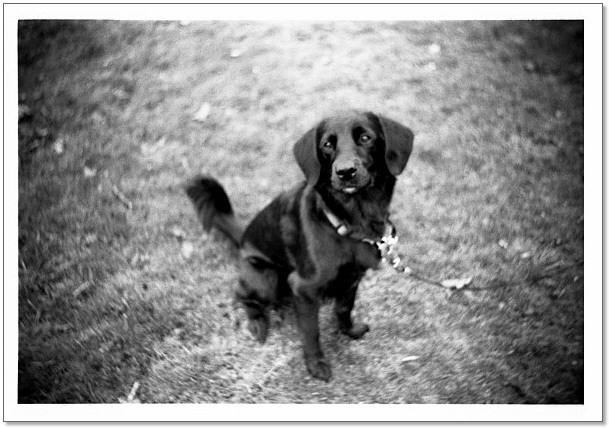Pentacon Electra
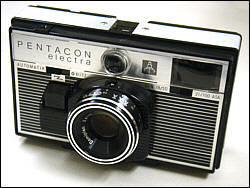
|
|
|
| Style, film format | 35mm scale-focus camera |
|
|
|
| Lens, shutter | Coated f/2.8 45mm Domiplan (triplet) in electronically controlled leaf shutter |
|
|
|
| Photo quality | To come |
|
|
|
| Ergonomics | Very boxy, slightly painful |
|
|
|
This is a curious camera that isn't often seen in the U.S., although I've read that it's common in Europe, which should come as no surprise.
I made the mistake of reading a bit about this camera. I usually try not to do that, so it doesn't influence what I want to write.
This camera came from Poland, a former Eastern bloc nation and the first to break away from communist rule. The camera was made by Pentacon, which was formerly East German Zeiss Ikon, before courts ruled that the Zeiss Ikon brand belonged to the West German operation. Ironically, Pentacon outlived Zeiss Ikon.
My first thought when I opened the box? Man, I forgot that some people just love to smoke. The camera and its leather case reeked of cigarette smoke. In time, that will disappear.
Let's get past that.
The camera is boxy and uses a good bit of plastic in its construction. There are two satin-finish metal strips (aluminum, I think) that cover the top and sides.
The front of the camera has a sort of funky aluminum face with a series of decorative white-on-black horizontal lines. Sort of art deco but well past the art deco era -- even for the Soviet bloc.
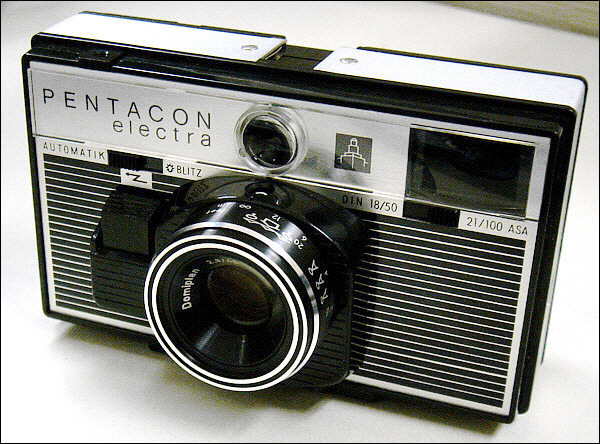
Directly above the lens is a circular window, which is the meter eye. The viewfinder is in the traditional spot to the right of the lens (with the camera facing you).
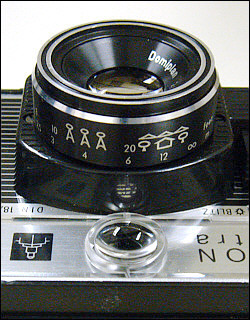
The focusing f/2.8 45mm Domiplan is marked in meters and feet, with the feet markings interrupted by some unusual symbols. Beneath the lens is a small lever, which sets the aperture, which is indicated by a different group of four symbols that can be seen in a circular cutout atop the lens.
On either side of the lens is a slide switch. One sets the film speed (ASA 50 or 100 / DIN 18 or 21), while the other sets the exposure as automatic or flash (Blitz).
The shutter release is on the front of the camera, and takes a bit of practice so you release the shutter without moving the camera.
I should mention now that the camera is aperture-priority autoexposure, although there is no indicator of shutter speed or correct exposure. There also is no lamp to let you know if the batteries are dead. I don't have a manual, so I'm not sure of the shutter speed range, but it seems like it's maybe five or six seconds to 1/200 or so.
Let's continue our tour of the camera. The Electra uses special cassettes. From what I've read, the cassettes were made by film maker Orwo. I don't have them. However, the Agfa Rapid cassettes seem to fit and work perfectly. You'll need two of them, and you're limited to 12 shots per roll, because the system works by pushing the film into an empty cassette. At a certain point, you can only push so much film, and 12 exposures seems to be the limit.
The camera's frame counter counts down. After two blanks, the frame counter starts at 12.
The film feeds from right to left, and you advance the film by turning the serrated film dial from right to left.
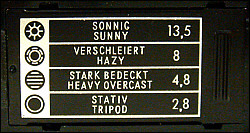
The Electra's exposure system is powered by two AA batteries, and the aluminum battery chamber cover has an aperture conversion guide. It converts the symbols on the lens to actual aperture numbers. In this case, f/2.8, f/4.8, f/8 and f/13.5. Needless to say, f/4.8 and f/13.5 are nonstandard and somewhat bizarre. An interesting thing is the use of 10 blades to form the aperture. I say this, because many lens makers had moved to five blades for their lower-cost lenses (and even for premium lenses), and the Domiplan (a triplet) sits squarely in the budget territory.
On the bottom of the camera is a plastic tripod socket. I would exercise care when attaching this to a tripod.
This particular camera had a few minor issues. There was some corrosion in the battery chamber, which I was able to clean.
The slide that locks the back wouldn't return to its normal position. A small spring that keeps it in place had rusted and broke. I clipped the tips from a safety pin, and with a bend in the correct spot, I was able to get it back into place and working correctly.
I also wiped down the camera. For the leather case, I wiped down the interior and used some saddle soap to clean the outside, following it with some black shoe polish. I've done this several times in hopes of removing the cigarette smoke odor.
Without a battery, the shutter simply stayed open but not all of the time, leading me to think that I might have to flush the shutter. With fresh batteries installed, the autoexposure system seemed to work correctly.
I have several Agfa Rapid cassettes, so I loaded one with 14 frames of Agfapan APX 100. It was now time to take the camera for a spin.
Because it's autoexposure, the photographer has only two technical tasks: Select the aperture and focus the lens. There is no rangefinder, so you'll be guessing the distance. It's an acquired skill, and the more that you do this, the more accurate you get.
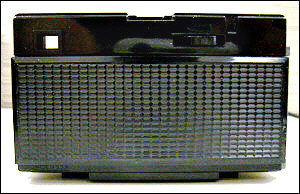
Ergonomics are what you would expect. Although the rectangular shape has been used prolifically through the years, from the Zeiss Ikon Contax I to the most famous of them all, the Argus C3 "Brick" to too-numerous-to-count Instamatics, it's a shape that should be abandoned and never used again.
A brick-shaped camera -- even a plastic one -- is uncomfortable to hold and to use. The fact that the front panel is slightly recessed means that the Electra's sharp plastic edges dig into your fingers.
I wasn't put off by the prolific use of plastic, and I found the camera fun in a funky 1960s retro way. This is definitely not a hippie camera, however, because it was born behind the Iron Curtain, where hippie culture didn't quite settle.
The camera was easy to use, because you only have to be concerned with setting the aperture and setting the focus. I've shot one roll with the camera out of the case, and I'll shoot the next roll with the camera in the case.
